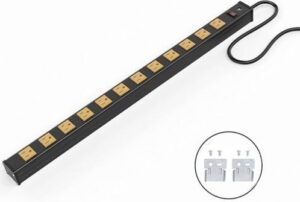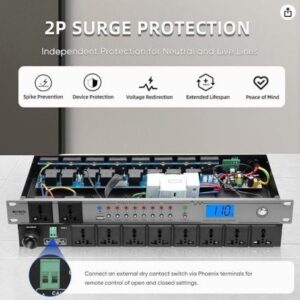
The Good A/C Power – Providing Healthy ‘Electric Juice’ to Your Audio Gear
Greetings Dynastar Fans:
Today let’s discuss providing good A/C power to your gear, and associated issues with that. Yea…It’s not just about having good audio cables.
First let’s discuss the type of gear and their specific power needs. The question is how much power do these products draw from the wall? Specifically, how much current do they require? So we have Volts, Amps (or current), Resistance, and Watts. These are the variables that make up ‘Electricity’ if you will.
An extension cord that is 100ft long powering up a bunch of tube amps, lighting, etc. at the end of the cord — RESISTANCE in the extension becomes an issue. The voltage can drop and could cause erratic issues especially with digital electronics. Most of the time, people get away with it, but… there’s always that one set up that is just right for intermittent failure. Then it ends up on the magic Dyna-bench only to see that it gets evaluated as ‘NAD’ – NO APPARENT DEFECT. Then $$ for nothing. A heavy gauge extension cable is necessary.
Small wall adapters for effects loops and smaller keyboards used with small extension cords are just fine.
Tube amps start to draw more power from the 250W-600W range. If the power is poor, they can usually take a beating.
Portable stage lighting has improved a bit being LED technology over incandescent type as it was years ago, but still, an array of lights can start to draw significant current. Lighting should be on separate power lines to reduce or illuminate noise feeding into audio gear, especially high gain guitar amplifiers.
Next we have pro-audio. i.e. powered speaker cabs, power amplifiers, and more sophisticated digital mixers. These units with the newer circuit topologies can be very sensitive to A/C power surges, and must have good electrical connections that are not intermittent. Low quality gear is susceptible to damage. Power amps peak into the thousands of watts. The load on your power line appears when they are in use, not turned on sitting idle.
Don’t think that because the devices power up, all is well. The outlet connections need to be good and solid. This is problematic in the field; old clubs, poor gen-sets, etc. Small amounts of arcing can occur where plug meets outlet. Nothing wrong with a little bit of silicone dielectric grease applied to the A/C plug prongs to reduce this phenomenon. So here is the deal: Reduce the number of A/C plug/outlet contacts as much as possible. Ideally, PLUG-TO -WALL. Well…. on stage that is probably not going to happen unless it’s a small gig in the corner of a bar or something.
There are well made power conditioners on the market, and may be well worth it depending on the dollar cost of gear you are trying to protect. Surge suppressors are also okay, but not like a power conditioner. You should note that often, a low cost surge suppressor has as its core component a simple component called a Metal Oxide Varistor which clamps voltage spikes before they reach your gear. The problem with MOV’s is that they are slow, and very fast high voltage spikes can still get through and cause damage. They do catch most of the hash coming through. A better component to implement into a power strip but requires a bit more circuitry is a Transient Voltage Suppressor (TVS) as its core component. They are an extremely fast reacting device made to capture voltage spikes and clamp very well. The speeds TVS’s can respond to are in the nanoseconds! So if you happen to be connected to a gen set out in the field which is often a very dirty power producer, they can take care of business when an electrical fault races down the line.
Let’s look at some no-no’s.. BTW.. we are all guilty when in an electrical bind… right?
Pic 1: This is not really good, but at least the extension cord has a larger gauge.. 10AWG is best but bulky, 12AWG is second choice, 14AWG not too bad, and 16 or 18AWG is going to be for light electrical loads.. Make sure the cord is safely listed. The strip you see is low quality, and does not provide a good solid electrical connection and is more susceptible to arcing.

Pic 2: This is a non-no.. Don’t do it.. They even tell you not to do it.

Pic 3: If you need multi-taps, this lays nicely on stage, and there are some with a nice long cable on them. Allows room for adapters. The outlets are quality.. Yes it’s bulky.

Pic 4: A power conditioner is the way to go at premium expense. If you have expensive gear out in the field, it’s the way to go, and it manages all kinds of faults. Several manufacturers make them.

A little bit of dielectric grease applied to all three pins (or two) on plugs reduces arcing, and can help the power stay clean. Heat fatigues electrical connections. This helps. Additionally, it allows you to plug and unplug stuff easier via lubrication – a side bonus for sure.

So in conclusion, if you need to run long distances, use larger gauge cables along with high quality power strips; don’t cascade strips together, and that should help you have healthier power.
Dynaman…

